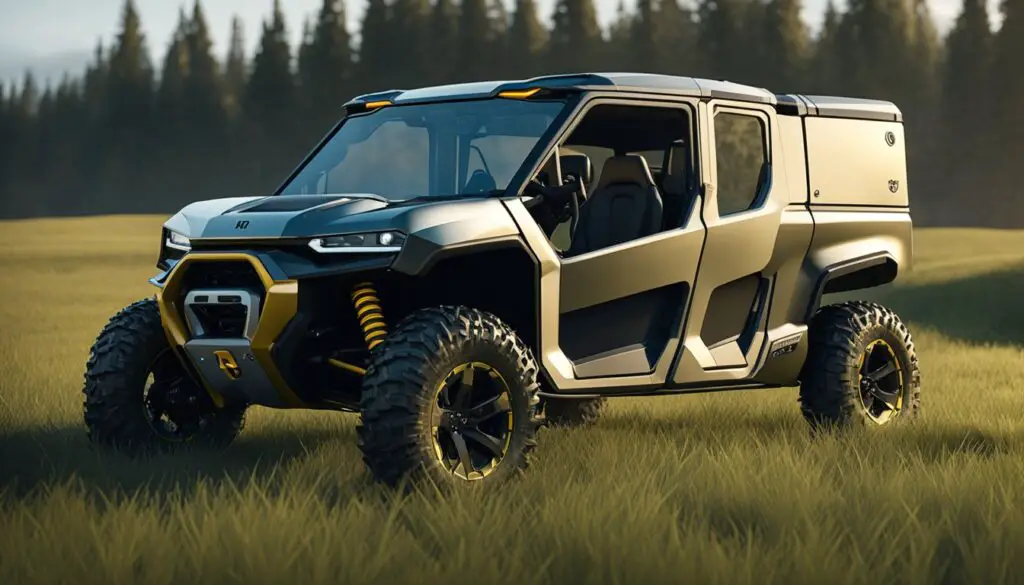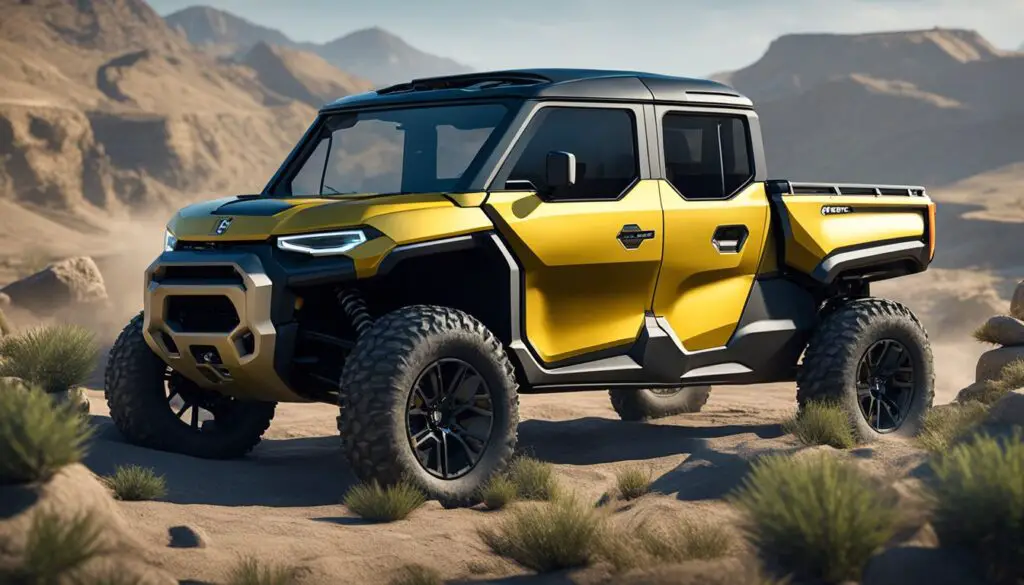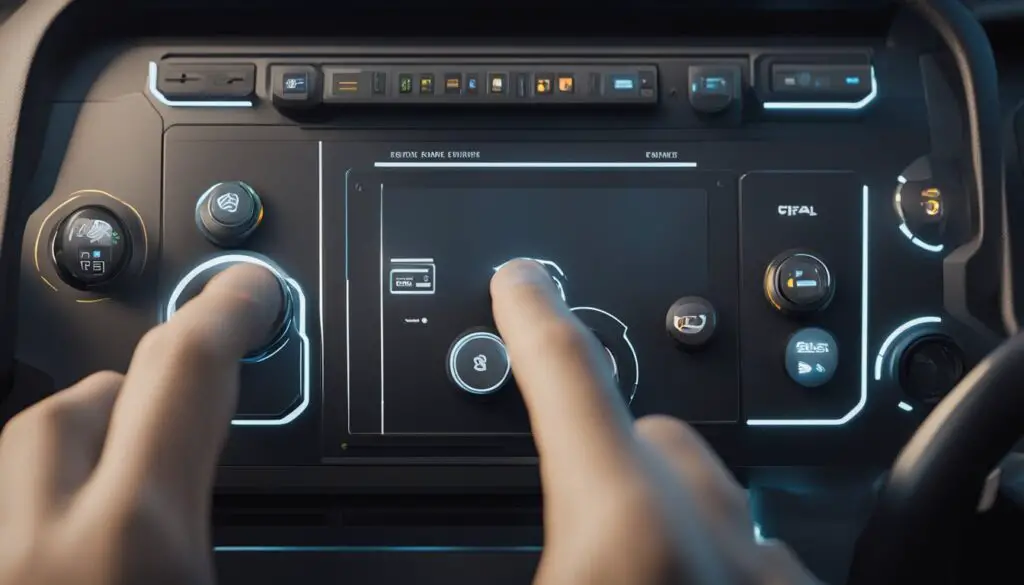When tackling challenging terrain with your Can-Am Defender, the turf mode provides a significant advantage. This versatile feature allows better traction on sensitive surfaces, such as grass, by unlocking the rear differential for less aggressive turns. However, some users have reported difficulties with engaging or disengaging turf mode, especially while performing tasks that put the vehicle under strain, such as pulling another vehicle out of the mud. These challenges do not detract from the Defender’s reputation as a robust utility vehicle, but they do merit a closer look to ensure your experience is smooth and hassle-free.

Understanding the intricacies of turf mode on your Can-Am Defender not only improves your vehicle’s performance but also ensures that you are able to rely on it in scenarios where delicate handling is paramount. The ability to traverse various landscapes without damaging the turf underscores the Defender’s design as a utility vehicle that respects the environment it operates in. Regular maintenance and knowledge of troubleshooting common issues will help you maintain the reliability and longevity that the Can-Am Defender is known for.
Key Takeaways
- Turf mode is vital for protecting delicate terrain and improves the Can-Am Defender’s versatility.
- Proper engagement and maintenance of turf mode enhance vehicle performance and longevity.
- Awareness of common issues and troubleshooting methods ensures reliability and safety.
Understanding Can-Am Defender
In this section, we’ll dive into what makes the Can-Am Defender a reliable utility vehicle, with a special focus on its Turf Mode, designed to minimize ground disturbances.
Design and Specifications
The Can-Am Defender is a robust utility vehicle tailored for off-road challenges. It’s built to deliver both performance and versatility, whether that be on a farm or rugged outdoor trails. Your experience is enhanced by a range of models, such as the Defender XMR known for its deep-mud abilities, or the Defender Limited for those who prioritize comfort. Specifications vary by model but generally include:
- Chassis & Dimensions: Heavy-duty steel frame, accommodating various payloads.
- Engine: Multiple engine options, like the HD7, that provide sufficient power.
- Towing & Hauling: High towing capacity for utilitarian tasks.
- Wheels & Tires: Designed for diverse terrains, offering stability.
- Seating: Ergonomic seating to handle long rides comfortably.
Turf Mode Overview
Turf Mode on the Can-Am Defender is all about protecting the ground beneath you. It’s especially useful when you desire to traverse over delicate surfaces without causing damage. By engaging Turf Mode, you activate a smart system that allows:
- Gentle Turns: The rear wheels can turn independently, reducing the chances of tearing up the lawn or other sensitive terrains.
- Versatility: Switching in and out of Turf Mode adjusts your vehicle’s traction on-the-fly, tailored to your current landscape.
- Traction Control: Maintains the ease of handling, even in this mode, making your off-road experience enjoyable without compromising on surface conservation.
Remember to disengage Turf Mode when it’s not required to ensure you’re getting the full traction capabilities of your Can-Am Defender when you need it most.
Common Turf Mode Issues
Encountering issues with the turf mode on your Can-Am Defender can be frustrating. These issues typically manifest as engagement problems or performance hiccups, impacting your vehicle’s operation.
Engagement Problems
Your Can-Am Defender’s turf mode is designed to allow easier maneuvering and prevent lawn damage by enabling one rear wheel to rotate independently. However, you might face the following:
- Failure to Engage: At times, turf mode may not activate when you flip the switch. This could be a result of a faulty solenoid or electronic control issues.
- Unexpected Disengagement: Turf mode might disengage during use, typically due to mechanical failures within the actuation system or worn-out components.
Performance Hiccups
When turf mode is engaged but not performing optimally, you’ll notice:
- Unusual Noise: Be alert for strange sounds that can indicate mechanical problems or the need for lubrication of moving parts.
- Steering Difficulty: If you experience steering trouble while in turf mode, it could be a sign of issues within the differential system, affecting the performance.
Technical Troubleshooting

In this section, you’ll learn how to pinpoint and resolve turf mode issues with your Can-Am Defender’s electrical and mechanical components. Armed with a systematic approach, you can effectively troubleshoot most common problems.
Electrical System Diagnostics
Your Can-Am Defender’s turf mode may be impacted by electrical system issues. Start with the battery, ensuring it’s fully charged and able to hold a charge. Use a multimeter to check the voltage; you should see around 12.6 volts on a charged battery.
Next, thoroughly inspect the wiring. Look for:
- Frayed wires
- Loose connections
- Corrosion at terminals
Troubleshoot the starter by listening for a click when attempting to start the engine; no click could indicate a failed starter or a battery issue. If the starter turns but the engine doesn’t, check the fuel pump wiring and connections.
Diagnose further electrical issues by examining any error codes using the onboard diagnostics, if available.
Mechanical Component Inspection
When you examine the mechanical aspects, the air intake system should be your starting point. Ensure there’s no blockage that could lead to overheating issues. Then, verify the coolant levels are within the recommended guidelines to prevent overheating as well.
Here’s a checklist for the mechanical inspection:
- Air filter: Confirm it’s clean and properly seated.
- Coolant: Check levels and look for leaks in the system.
- Belts and pulleys: Inspect for wear and proper tension.
Maintenance and Preventive Care
Taking care of your Can-Am Defender, especially the turf mode, is crucial. Proper maintenance and timely upgrades can significantly extend the life and performance of your utility vehicle.
Regular Service Routines
To ensure your Can-Am Defender’s turf mode remains in top shape, you’ll want to establish a routine that includes checking and servicing key components:
- Engine: Regularly inspect the engine oil level and replenish or replace as necessary. Keep an eye out for oil discoloration and metal shavings, which indicate the need for a deeper examination.
- Transmission: A belt-driven transmission requires frequent checks. Inspect the belt for any signs of wear and tear and replace it preemptively to avoid unexpected breakdowns.
- Coolant Level: Verify the coolant level often, and top up with the appropriate type to maintain optimal engine temperatures and prevent overheating.
- Spark Plugs: Check and replace your spark plugs according to the manufacturer’s schedule to ensure your engine runs smoothly.
Follow the recommended schedule for these checks in your owner’s manual to stay on track.
Upgrade Recommendations
Over time, parts wear out or become obsolete. Consider these upgrades for improved turf mode functionality:
- High-Performance Belt: Upgrade to a high-performance belt for better durability and power transmission.
- Cooling System Enhancements: Enhanced fans or a larger radiator can help to manage engine heat more effectively, especially in demanding conditions.
By adopting a careful maintenance schedule and considering strategic upgrades, you can keep your Defender’s turf mode running efficiently for years to come.
Repair and Solution Strategies
When your Can-Am Defender exhibits turf mode problems, like a belt issue or loss of power, you’ll find effective solutions split between professional services and your own DIY efforts. Let’s guide you through both.
Dealer and Professional Services
If you’re facing a loss of power or a reverse chain breakage, your first port of call should ideally be the dealer. Authorized dealers have the expertise and tools necessary to diagnose and remedy complex issues correctly. Here’s what you can expect:
- Diagnosis: A thorough assessment to identify the underlying cause of your turf mode issue.
- Repair: Professional repairs that might include replacing a broken reverse chain or solving belt problems.
- Warranty: If your Defender is under warranty, the dealer might fix the issues at no additional cost.
DIY Fixes and Tips
For those who prefer to get hands-on with their Defender, some turf mode problems can be tackled at home. Ensure you have the right tools and follow safety procedures. Here’s what you should know:
- Belt Inspection: Regularly check your belt for wear and replace if necessary. This can prevent larger issues down the line.
- Loss of Power: Clean air filters and ensure proper fluid levels to mitigate power loss.
- Reverse Chain: If you’re skilled enough, replacing a reverse chain can be done at home, but it requires specific knowledge of your Defender’s transmission system.
Remember, while DIY fixes can be gratifying, some problems might require professional intervention to ensure your safety and the longevity of your UTV.
Handling Specific Components

When working with your Can-Am Defender, paying attention to steering and suspension systems, as well as the cooling management, is essential for maintaining turf mode functionally and overall ride comfort.
Steering and Suspension Adjustments
Your Can-Am Defender’s steering might exhibit problems if not handled properly. It’s important to check and adjust the steering rack and tie rods regularly to ensure precise control and response, especially during turf mode operation where independent wheel movement is crucial. Similarly, a well-adjusted suspension supports improved handling and acceleration, reducing strain on the vehicle.
- Check:
- Steering rack for proper alignment
- Tie rods for wear and correct tension
- Adjust:
- Suspension settings to match your typical load and riding conditions.
Cooling System Management
Effective cooling system management is pivotal to avoid overheating while operating in turf mode, as higher temperatures can arise from constant low-speed use. Regularly monitor your coolant levels and inspect the radiators to confirm there’s no blockage. Furthermore, verify the cooling fan is operating correctly and the thermostat is opening at the designated temperature to prevent potential overheating.
- Inspect:
- Radiator for any obstructions
- Coolant levels, ensuring they’re within recommended ranges
- Ensure:
- The thermostat is functional
- Cooling fan engages at the appropriate times
Real-World Utility and Longevity
When you’re investing in an off-road utility vehicle like the Can-Am Defender, you want to be sure it stands up to the rigors of real-world use. In terms of longevity and reliability, here’s how this machine performs across different scenarios.
Off-Road and Farm Use
The Can-Am Defender is designed to tackle tough terrain, whether it’s the rocky path on your property or the muddy fields of your farm. Its 4×4 system, which includes the Turf Mode, allows you to maneuver across delicate surfaces without tearing up the ground. This feature is particularly useful for farm and ranch activities, where the landscape can be as varied as the tasks at hand.
- Longevity: Regular maintenance and proper usage significantly increase the Can-Am Defender’s lifespan in off-road conditions.
- Reliability: Users report dependable performance during extensive property management tasks, highlighting the vehicle’s suitability for a variety of environments.
Durability and Load Handling
Your Can-Am Defender’s built-in cargo capacity is engineered for heavy-duty tasks. Whether you’re hauling feed across your farm or towing equipment, the Defender can handle substantial weight without compromising on performance.
- Durability: Strong construction with quality materials ensures durability over time, even when regularly exposed to harsh conditions.
- Load Handling: It’s important to adhere to the recommended limitations for hauling and towing to prevent undue stress on the vehicle, safeguarding its longevity.
Optimizing Vehicle Performance
To elevate your Can-Am Defender’s performance, focusing on specific upgrades and fine-tuning key systems will make a noticeable difference. These enhancements can help you maintain optimal vehicle efficiency and reliability.
Aftermarket Upgrades
When considering aftermarket upgrades, think about how each component will interact with your vehicle’s turf mode capabilities. Essential upgrades that can improve performance include:
- Brakes: Upgraded brake pads and rotors can provide you with better stopping power and improved control.
- Power Steering Pump: A high-quality power steering pump can offer smoother steering response, which is particularly beneficial in challenging terrains.
Fuel and Air Intake Enhancements
Enhancing your Can-Am Defender’s fuel and air intake systems can lead to a more responsive and powerful ride. Implement these enhancements with precision:
- Snorkel: Installing a snorkel can help you avoid water ingestion during water crossings and improve engine breathing.
- Pre-Filter: A pre-filter adds an extra layer of protection against dust and debris, ensuring cleaner air reaches your engine.
- Fuel Delivery: Consider upgrading the fuel delivery system for more consistent fuel flow, which can help maintain performance under various conditions.
Safety and Reliability Concerns
When it comes to your Can-Am Defender’s turf mode, safety and reliability should be your top priorities. You’ll want to ensure that all mechanical and electrical systems function correctly to avoid potential hazards.
Addressing Recalls and Design Flaws
Recalls are a clear signal that the manufacturer has identified safety concerns or design flaws in your vehicle. It’s crucial for your safety to stay informed about any recalls involving the turf mode feature of your Can-Am Defender. If a recall has been issued:
- Check if your Defender is affected: Verify your vehicle identification number (VIN) with the manufacturer’s recall notice.
- Respond promptly: Follow the manufacturer’s instructions to have the issue rectified at an authorized dealer.
Recalls often address challenges in steering components or the brake pedal, which are critical for your Defender’s safe operation.
Reinforcing Critical Systems
To maintain a high level of reliability, you should pay special attention to reinforcing the vehicle’s critical safety systems. Regular maintenance checks can thwart many potential problems before they compromise your safety.
- Brake System: Ensure that your brake pedal is responsive and that brake pads are in good condition.
- Steering Components: Invest in regular inspections to catch any wear or weak points in the steering mechanism.
Frequently Asked Questions
Navigating issues with your Can-Am Defender’s Turf Mode can be straightforward when you know what to look for. This section answers some common concerns you might have.
What are the common issues with Turf Mode on the Can-Am Defender?
You might experience difficulties with Turf Mode disengaging or failing to activate. Some users report unusual noises or a lack of differential lock when Turf Mode is supposed to be functioning.
How does Turf Mode on different years of Can-Am Defender compare?
Earlier models of the Can-Am Defender may have less refined Turf Mode systems, potentially leading to more frequent issues. Newer models typically incorporate updates and fixes that can result in improved performance.
Is there a known fix for Turf Mode issues in the Can-Am Defender?
Yes, in some cases recalibration or software updates provided by the manufacturer can resolve Turf Mode issues. It’s also worth checking for any physical damage to the mechanism.
What steps should be taken if Turf Mode stops working on a Can-Am Defender?
First, inspect for any visible signs of damage. If none are found, consult the owner’s manual for troubleshooting tips or take your Defender to a certified dealer for diagnosis and repair.
How does disabling Turf Mode affect the performance of a Can-Am Defender?
Disabling Turf Mode may lead to increased wear on grass and other delicate terrain, as the feature is designed to minimize damage when making tight turns. Without it, your vehicle’s handling may also differ.
Are there any recalls or service bulletins regarding the Can-Am Defender Turf Mode?
Check with your local dealership or the manufacturer’s website for any service bulletins or recalls related to Turf Mode on your model of Can-Am Defender.

Leave a Reply